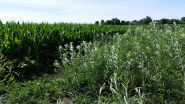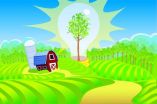In collaboration with the farming community of the Indian Creek Watershed in central Illinois, these researchers are finding ways to simultaneously meet three objectives: maximize a farmer's production, grow feedstock for bioenergy and protect the environment. These goals, as it turns out, are not necessarily mutually exclusive.
All it takes is a multifunctional landscape, where resources are allocated efficiently and crops are situated in their ideal soil and landscape position. Planting bioenergy crops like willows or switchgrass in rows where commodity crops are having difficulty growing could both provide biomass feedstock and also limit the runoff of nitrogen fertilizer into waterways -- all without hurting a farmer's profits. This is what a group of Argonne scientists has discovered through careful data collection and modeling at a cornfield in Fairbury.
"The issue we're working to address is how to design bioenergy systems that are sustainable" said Cristina Negri, principal agronomist and environmental engineer at Argonne. "It's not idealistic. We wanted to show that it's doable; if we design for specific outcomes, we'll see real results."
So Negri and her team created a pilot farm site that balances the priorities of economic feasibility, bioenergy and environmental health.
Meeting this challenge called for a change in perspective. Rather than looking at whole fields as the unit of planting decisions, researchers analyzed subareas of the cornfield. They found that subareas with the lowest yield also had the lowest nitrogen retention. These sections of land are doubly taxing -- unprofitable for the farmer and damaging to the environment.
Negri explained what happens in the underproductive land: "Imagine pouring a nice, nutrient-rich solution through a fertile soil with plants growing in it," she said. These nutrients would be retained by the soil long enough to be taken up by plants, minimizing any leakage. "Now imagine pouring this same solution through a colander: If nutrients filter through the soil too quickly, they're no longer available for plants. The corn grows less, and more nitrogen is leached into groundwater."
But planting bioenergy crops in the colander-like soil could solve both problems -- environmental and economic -- as the Argonne team showed with the Denitrification Decomposition simulation.
Willows and switchgrass are perennial bioenergy crops, meaning their life cycle spans multiple years. These plants have a more extensive root system than annual plants, which start their growth from scratch every year. Deeper roots are better able to absorb nitrogen as it seeps deeper into the soil.
The loss of nitrogen from agricultural land is a major environmental concern. If not retained by soil or taken up by plants, nitrogen escapes into air or water. It is released into the atmosphere as nitrous oxide, a greenhouse gas with 310 times the warming potential of carbon dioxide. Nitrate leaking into water spurs oxygen depletion that harms aquatic ecosystems and can lead to toxic algal blooms, as seen in Lake Erie. The Fairbury cornfield is located within the Indian Creek Watershed, draining to the Vermilion River and eventually to the Gulf of Mexico, which for years has been suffering from oxygen depletion caused by nutrient runoff.
While scientists may be invested in energy and environment, the team recognized that farmers -- the true agents of change -- have to think first and foremost about their economic bottom line.
"Across the entire field your farm might be profitable, but by collecting more specific data we can identify subareas where the farmer is not recovering his or her investment," said Argonne postdoctoral researcher Herbert Ssegane.
The money lost comes from farmers cropping and applying expensive nitrogen fertilizers to patches of the field that are just not producing enough. Inserting rows of bioenergy crops where there is low corn yield means the farmer is not sacrificing substantial profit from row crops. As a cost-saving bonus, the deep-rooted bioenergy crops naturally accumulate the lost nitrogen as a free fertilizer.
Argonne scientists planted willows at the Fairbury site in 2013 and will continue collecting data through next year to see how results compare to their predictions. "We've already reached a 28 percent reduction in nitrate, even with two full growing seasons still ahead of us," Ssegane said. Willow growth has also been good, without the researchers applying any fertilizer.
According to Ssegane, this project is about proving a concept. It shows farmers that strategic planting of bioenergy crops can increase productivity and save money, while demonstrating to the scientific community that bioenergy will be sustainable if we match plants to their optimal position within a landscape.
"Before this work, the popular idea was 'dedicated fields,' where you might convert a large area from corn to switchgrass," Ssegane said. "But dedicated fields of bioenergy crops are currently inviable in an agricultural setting where the economy is tied to grain. What does pass the cost-benefit test is converting underproductive subareas to an alternative crop."
A multifunctional landscape finds the happy, efficient medium between a dedicated bioenergy field and a farm growing continuous acres of the same cash crop.
The scientists are exploring how these design principles can be scaled up to the entire watershed. Eventually, they hope this research informs agricultural planning for scientists and farmers alike.
INFORMATION:
"Multifunctional landscapes: Site characterization and field-scale design to incorporate biomass production into an agricultural system," the most recent paper analyzing data from Fairbury, was published in the journal Biomass and Bioenergy. Funding for this research comes from the DOE's Office of Energy Efficiency and Renewable Energy, Bioenergy Technologies Office.
The Department of Energy's Office of Energy Efficiency and Renewable Energy (EERE) accelerates the development and deployment of energy efficiency and renewable energy technologies and market-based solutions that strengthen U.S. energy security, environmental quality, and economic vitality. Learn more about how EERE's Bioenergy Technologies Office supports the development of a sustainable bioenergy industry through its Sustainability Program.
Argonne National Laboratory seeks solutions to pressing national problems in science and technology. The nation's first national laboratory, Argonne conducts leading-edge basic and applied scientific research in virtually every scientific discipline. Argonne researchers work closely with researchers from hundreds of companies, universities, and federal, state and municipal agencies to help them solve their specific problems, advance America's scientific leadership and prepare the nation for a better future. With employees from more than 60 nations, Argonne is managed by UChicago Argonne, LLC for the U.S. Department of Energy's Office of Science. For more, visit http://www.anl.gov.
The Department of Energy's Office of Science is the single largest supporter of basic research in the physical sciences in the United States, and is working to address some of the most pressing challenges of our time. For more information, please visit science.energy.gov.




